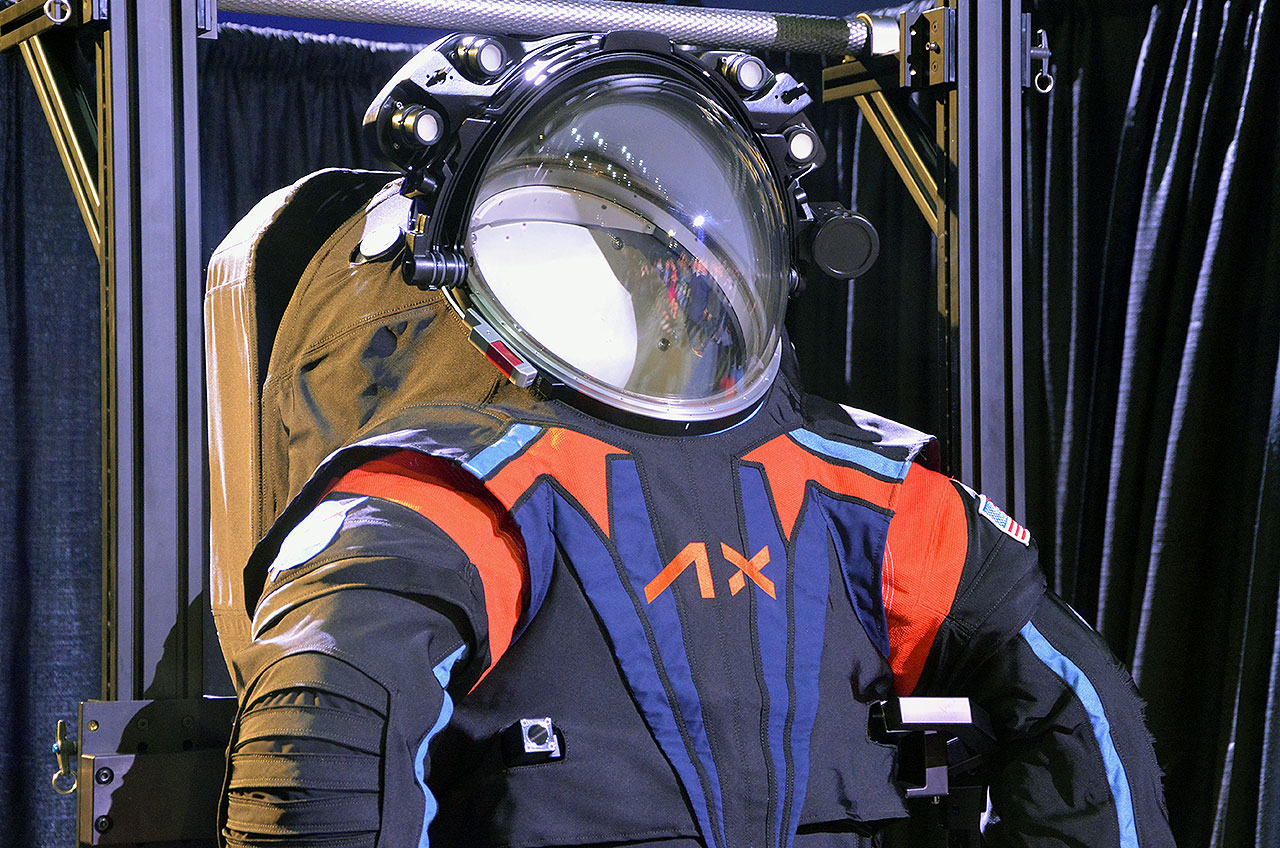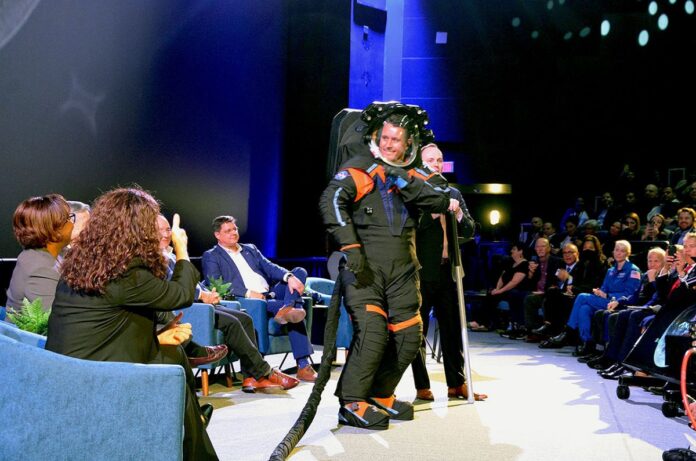The history-making spacesuits worn by the first woman and next American astronaut to walk on the moon will be abandoned on a SpaceX lunar lander rather than be returned to Earth for their reuse or museum display.
Axiom Space, the Houston-based space services company selected by NASA to design, build and furnish the spacesuits for the 2025 Artemis 3 lunar landing mission, unveiled a prototype of its lunar garb (opens in new tab) during a press event at Space Center Houston on Wednesday (March 15). Axiom president and CEO Michael Suffredini and Mark Greeley, the company’s program manager for extravehicular activity, spoke about the fate of the Artemis 3 spacesuits (opens in new tab) in a brief interview.
“They will go up on Starship, and then the crew will transfer over from Orion to Starship to go down to the lunar surface,” Greeley told collectSPACE, referring to how the two garments would first get to the moon.
NASA’s approach to achieving the first lunar landing in more than 50 years differs from the last time it went with Apollo, in that the crew launches separately from the moon lander and then they rendezvous in lunar orbit. Four Artemis 3 astronauts will depart Earth aboard the Lockheed Martin-built Orion capsule. Once at the moon, two of the crew members will transfer over to the human landing system, a version of SpaceX’s Starship spacecraft (opens in new tab), while the other two stay in lunar orbit aboard Orion.
At the end of the mission’s surface operations (opens in new tab), the two Artemis moonwalkers — including the first woman to land on the moon — will lift off on Starship and then rendezvous with Orion to return to Earth. Due to weight constraints, only the small stash of moon rocks they bring back from the lunar surface, and perhaps some low-mass equipment, will be transferred to Orion for the trip home.
“The spacesuits will go back on Starship, and then Starship will remain in [lunar] orbit indefinitely,” said Greeley.
Related: Axiom Space reveals prototype spacesuit for Artemis astronauts on the moon
At least that is the plan for the two Axiom Extravehicular Mobility Unit (AxEMU) spacesuits used on the Artemis 3 mission as of Wednesday.
“That is the current thought process,” said Suffredini. “But this is several years from now, and those kinds of things do come up. So it wouldn’t surprise me if we had a conversation at some point as to what might be possible.”
“Perhaps gloves or some other small parts might come back,” added Greeley.
Once back from the surface of the moon, Starship will lack the fuel needed to fly back to Earth. The vehicle is designed so that it can be refueled, but for Artemis 3 in late 2025, no refilling station is expected to be available.
Whatever can and does come back from the moon, in terms of the AxEMUs, will be Axiom Space’s to do with as the company chooses.
“The suits are ours,” said Suffredini. ‘We’re providing a service, and that’s really important, because if we didn’t own them, we couldn’t sell services to others. That’s the whole concept behind this commercialization thing that NASA is doing. If NASA builds them, it is hard to sell services, but when we build it ourselves and provide NASA services, then we can also sell services to others. So we own that asset.”
If the Artemis 3 AxEMU spacesuits are disposed of in lunar orbit, it would not be the first time that the astronauts’ outfits from historic NASA missions were unable to be saved.
On the Apollo missions, NASA astronauts wore the same pressure garments to walk on the moon as they did to launch from and return to Earth, so the suits made the round trip (opens in new tab). The parts they added to enable working on the lunar surface, though, were often left behind to save weight.
Hence, the boots (or overshoes) that Apollo 11 astronaut Neil Armstrong wore to take his first “small step” are still at Tranquility Base.
Related: Apollo 11: Everything you need to know about the historic moon landing

During the space shuttle era, the only spacesuits lost were those aboard the ill-fated missions of Challenger and Columbia. Once it was decided to retire the winged orbiters, the initial thought was that NASA would stock the shuttle’s leftover spacesuit parts on the International Space Station (opens in new tab).
Lacking a vehicle with the required downmass capability, the plan for the extravehicular mobility units (EMUs) was to dispose of them as they aged out of service. The spacesuits would be allowed to burn up (opens in new tab) with other refuse packed aboard spent Russian cargo craft.
Ultimately, that did not come to be, as NASA turned to its commercial partners to fly crew and cargo to and from the space station. SpaceX’s Dragon spacecraft has since been used to land spacesuit components for servicing on Earth, enabling their continued reuse (opens in new tab).
Follow collectSPACE.com (opens in new tab) on Facebook (opens in new tab) and on Twitter at @collectSPACE (opens in new tab). Copyright 2023 collectSPACE.com. All rights reserved.

